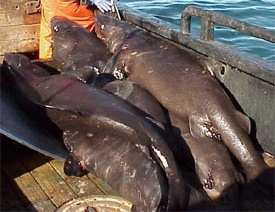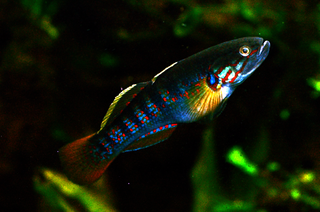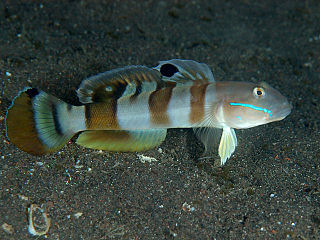
The Pacific sleeper shark is a sleeper shark of the family Somniosidae, found in the North Pacific on continental shelves and slopes in Arctic and temperate waters between latitudes 70°N and 22°N and in at least two places in the western tropical Pacific near Palau and the Solomon Islands, from the surface to 2,000 metres (6,600 ft) deep. The first evidence of the sharks in the western tropical Pacific emerged from a National Geographic video taken near the Solomon Islands in 2015. Its length is up to 4.4 m (14 ft), although it could possibly reach lengths in excess of 7 m (23 ft).
Squalidae, more commonly known as dogfish, dog sharks, or spiny dogfish, are one of several families of sharks categorized under Squaliformes, making it the second largest order of sharks, numbering 119 species across 7 families. Having earned their name after a group of fishermen reportedly observed the species chasing down smaller fish in dog-like packs, dogfish have slender, streamlined bodies, usually more compact in comparison to other species, and a pointed snout. Dogfish likewise have two dorsal fins, each with smooth spines, but no anal fin, and their skin is generally rough to the touch. As the species reaches adulthood, males usually measure a maximum of 100 cm, while females typically measure 125 cm long. The species therefore exhibits female-dominant sexual dimorphism.

Eleotridae is a family of fish commonly known as sleeper gobies, with about 34 genera and 180 species. Most species are found in the tropical Indo-Pacific region, but there are also species in subtropical and temperate regions, warmer parts of the Americas and near the Atlantic coast in Africa. While many eleotrids pass through a planktonic stage in the sea and some spend their entire lives in the sea; as adults, the majority live in freshwater streams and brackish water. One of its genera, Caecieleotris, is troglobitic. They are especially important as predators in the freshwater stream ecosystems on oceanic islands such as New Zealand and Hawaii that otherwise lack the predatory fish families typical of nearby continents, such as catfish. Anatomically, they are similar to the gobies (Gobiidae), though unlike the majority of gobies, they do not have a pelvic sucker.

The little sleeper shark is a small sleeper shark of the family Somniosidae found in the northeast Atlantic, western Mediterranean, and western Pacific around New Zealand, at depths between 200 and 1,000 m. Its length is up to 1.43 m.

Somniosus is a widely distributed genus of deepwater dogfish sharks in the family Somniosidae. Several members of the genus are believed to attain lengths up to 7 m (23 ft), thus ranking among the largest of sharks.

Valenciennea is a genus of small, bottom-dwelling fish in the family Gobiidae. They are found over sandy bottoms, often at coral reefs in the Indo-Pacific. The members of the genus tend to rest directly on the substrate for extended periods of time. While this is a common behavior for members of the family, this genus also float motionless directly above the substrate, which is why they are sometimes called glider gobies. Their resting behavior has resulted in the vernacular name "sleeper gobies", which invites confusion with the related family Eleotridae. The members of this genus are known to be carnivorous sand-sifters; to eat, they simply engulf entire mouthfuls of sand which they expel through their gills. Specialized structures in their gills filter small crustaceans and worms as the sand is expelled. It is this specific trait that makes some members of the genus attractive to the marine aquarist, and they are often introduced into a marine aquarium for sand-sifting. Some of the species are known to be monogamous. The genus was named after notable French zoologist Achille Valenciennes. These fish are difficult to keep in a tank. Tanks with plenty of live sand and live rock are recommended. Offer foods such as sinking shrimp pellets. Fish may die even if eating properly.

The southern sleeper shark or Whitley's sleeper shark is a deepwater benthopelagic sleeper shark of the family Somniosidae found in the southern Atlantic, Indian, Pacific, and Antarctic oceans.

Butis butis, the crazy fish, duckbill sleeper, or upside-down sleeper, is a species of sleeper goby that are native to brackish and freshwater coastal habitats of the Indian Ocean and the western Pacific Ocean from the African coast to the islands of Fiji. They prefer well-vegetated waters and can frequently be found in mangrove swamps. They are small, drably-colored fish, reaching a maximum length of only 15 cm (5.9 in). They are predatory and are known for their behavior of swimming vertically – or even upside down – while hunting.

Butis is a genus of fishes in the family Butidae found in fresh, brackish, and marine waters from the Indian Ocean coast of Africa through Southeast Asia to the Pacific islands and Australia.

The Gobiiformes are an order of fish that includes the gobies and their relatives. The order, which was previously considered a suborder of Perciformes, is made up of about 2,211 species that are divided between seven families. Phylogenetic relationships of the Gobiiformes have been elucidated using molecular data. Gobiiforms are primarily small species that live in marine water, but roughly 10% of these species inhabit fresh water. This order is composed chiefly of benthic or burrowing species; like many other benthic fishes, most gobiiforms do not have a gas bladder or any other means of controlling their buoyancy in water, so they must spend most of their time on or near the bottom. Gobiiformes means "goby-like".

The finless sleeper ray is a species of electric ray in the family Narkidae, and the sole member of its genus. It is found over the continental shelf of Southeast Asia from the eastern Andaman Sea to Vietnam and Borneo. Typically growing no more than 15 cm (5.9 in) long, it may be the smallest cartilaginous fish. The finless sleeper ray is the only electric ray that lacks dorsal fins. It has an oval pectoral fin disc that varies from longer than wide to wider than long, depending on age, and a short, robust tail that terminates in a short, deep caudal fin. The trailing margins of its pelvic fins are sexually dimorphic, being more concave in males.

Members of the family Narkidae are commonly known as sleeper rays. They are restricted to the temperate and tropical Indo-West Pacific from South Africa to Japan to Indonesia, and are exclusively marine and are absent from freshwater habitats. They occur from the intertidal zone to the continental shelf and the upper continental slope to a depth of 350 meters, favoring soft-bottomed habitats.

The Japanese sleeper ray is a species of electric ray in the family Narkidae. It is common in the inshore and offshore waters of the northwestern Pacific Ocean from southern Japan to southern China. Growing up to 40 cm (16 in) long, the Japanese sleeper ray has a nearly circular pectoral fin disc colored reddish to chocolate brown above, sometimes with darker or lighter spots, and lighter brown below. The spiracles behind its small eyes have raised, smooth rims. Its short and muscular tail bears a single dorsal fin positioned aft of the rounded pelvic fins, and terminates in a large caudal fin.

Eleotris is a genus of fish in the family Eleotridae with a circumglobal distribution in tropical and subtropical regions.

Calumia is a genus of fishes in the family Eleotridae native to the marine waters of the Indian Ocean and the western Pacific Ocean.

Dormitator is a genus of fishes in the family Eleotridae mostly found in marine, fresh and brackish waters on either side of the Atlantic Ocean, with one species occurring along the Pacific coast of the Americas.

Odonteleotris is a small genus of fishes in the family Butidae native to tropical marine waters of the western Pacific Ocean and fresh and brackish waters of southern Asia.
John Ernest "Jack" Randall was an American ichthyologist and a leading authority on coral reef fishes. Randall described over 800 species and authored 11 books and over 900 scientific papers and popular articles. He spent most of his career working in Hawaii. He died in April 2020 at the age of 95.















